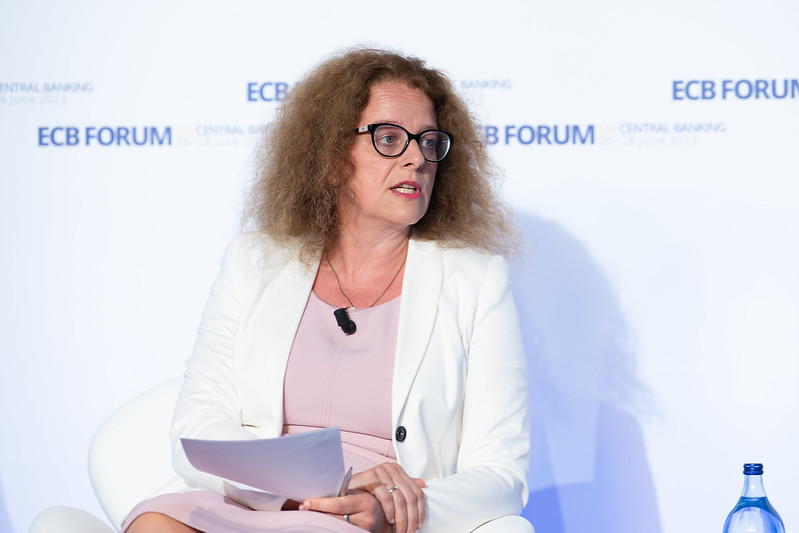ECB’s Schnabel: ‘We Are Getting Closer to a Point Where We Might Have to Pause Cuts’
19 February 2025

By Marta Vilar – MADRID (Econostream) – European Central Bank Executive Board member Isabel Schnabel said on Wednesday that the ECB was approaching the moment at which interest rate cuts might stop.
In an interview with the FT, Schnabel said that she currently did not see any reason to deliver insurance cuts for the sake of uncertainty, especially as the ECB was getting closer to no longer being restrictive.
‘If anything, we are getting closer to the point where we may have to pause or halt our rate cuts’, she added.
The neutral rate was not an appropriate tool to determine the next step the ECB should take, according to Schnabel, who argued that it did have an impact on the institution’s medium-term view.
‘I think r* cannot be any reliable guide for monetary policy in real time’, she said.
The natural rate of interest had been clearly moving up recently and that trend should continue, she said.
‘[T]he more evidence we have that monetary policy is no longer restrictive, the more cautious we have to become because further rate cuts may no longer be appropriate’, she said.
There was evidence that restrictiveness had decreased sharply, and the ECB could no longer be confident in stating that monetary policy was still restrictive, she said.
However, she confirmed that she agreed with the statement about restrictiveness in the January monetary policy statement.
‘But we are now a step further, right? The January monetary policy statement referred to the interest rate of 3% and the level of restrictiveness before the latest monetary policy decision’, she explained.
The more the ECB cut rates, the less confident she would be about monetary policy being restrictive, she said.
‘And note that I’m not saying our monetary policy is no longer restrictive’, she said. ‘What I'm saying is I’m no longer sure whether it is still restrictive. But we should not overstate a difference of 25bp.’
Asked if the ECB should remove the reference to being restrictive in the March meeting, Schnabel refused to give a yes-or-no answer.
‘That is a discussion we should have in the next meeting’, she replied.
The ECB was not behind the curve but was on the right track instead, she said.
Despite ruling out any interest rate hikes, Schnabel reaffirmed that the ECB was nearing the point where it could pause rate cuts.
Regarding how close that pause could be, she limited herself to saying that a discussion about it had to start.
Markets were ‘not entirely sure either’ about a rate cut in April, she said.
‘At the time when it was still relatively clear that monetary policy was restrictive, one could infer the direction of travel from that’, she said. ‘But this is no longer the case. And therefore, for me, the direction of travel is not so clear anymore.’
It was ‘quite important’ that services inflation and wage growth declined as expected in the ECB’s projections, she indicated.
Services inflation should start to decrease in February, according to Schnabel, who said this measure did not necessarily have to decline to 2% in order to achieve the target.
‘[W]age growth is expected to stay relatively elevated over the first half of the year’, she said. ‘So, we still need to see this deceleration. This is something that I pay a lot of attention to.’
Energy prices could forcefully impact on headline and core inflation, she said, and the ECB should ‘monitor this carefully’.
Risks to inflation are somewhat tilted to the upside, according to Schnabel, who did not rule out that inflation would return to 2% later than projected.
Schnabel suggested the ECB should reassess its reaction function in its strategy review in order to adapt to the rapidly changing inflation environment.
‘I believe that the new reaction function should be symmetric in order to take into account the risks in both directions’, she said. ‘This is especially true given that we are likely to face more adverse supply-side shocks going forward.’
Once the Eurozone returns to a ‘normal’ situation, where services inflation and wage growth have decelerated and inflation expectations are well anchored, the ECB should tolerate moderate deviations from the 2% inflation target.
‘We should stop fine-tuning and responding to single data points’, she said. ‘We should instead focus on large persistent shocks that give rise to a risk of a de-anchoring of inflation expectations in either direction.’
Related articles:
- ECB’s Schnabel: Rate Cuts Mitigate Economic Weakness, Not Structural Issues
- Key Quotes From Sunday’s German Media Interview With ECB’s Schnabel
- ECB’s Schnabel: ‘We Believe That We Are Still on the Right Track’, Must Watch Services Inflation
